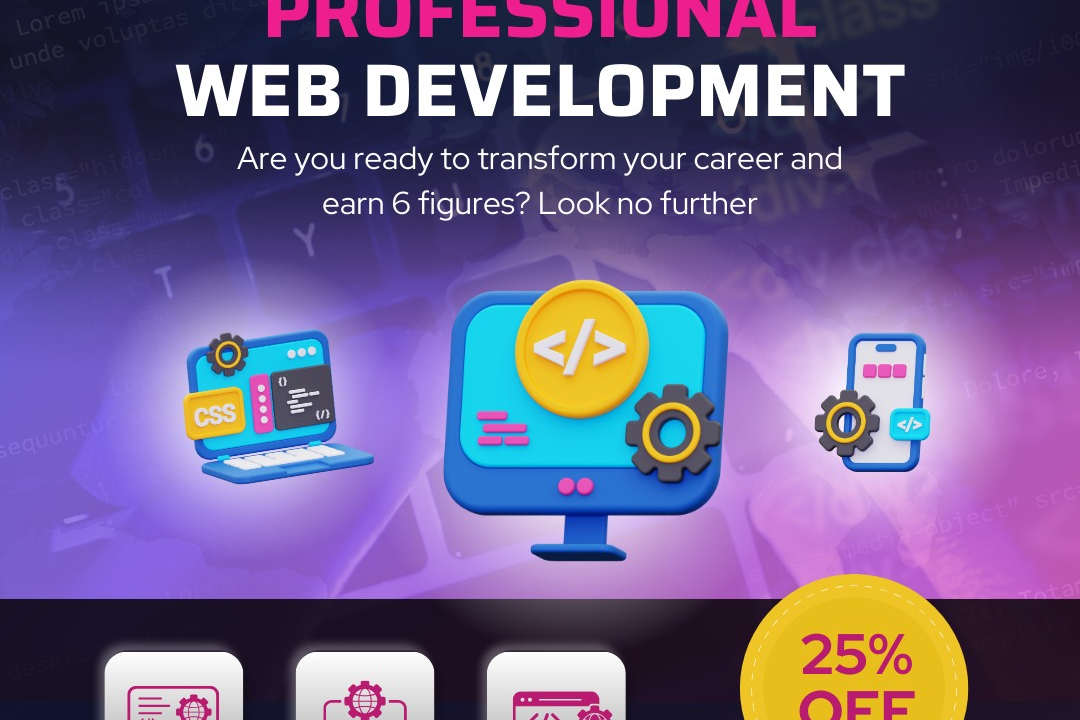Even Number Program In Php
An PHP program to check if a number is even is a simple script that determines whether a given numbe
Even Number Program In Php
An PHP program to check if a number is even is a fundamental example that helps beginners understand conditional statements, arithmetic operations, and user input handling in PHP. This simple program is useful for illustrating how to perform basic calculations and decision-making within a script, forming the foundation for more complex logic in programming. Additionally, such programs are employed in various applications like data filtering, input validation, and algorithm development, making them essential for developing problem-solving skills in real-world scenarios.
To Download Our Brochure: https://www.justacademy.co/download-brochure-for-free
Message us for more information: +91 9987184296
An PHP program to check if a number is even is a fundamental example that helps beginners understand conditional statements, arithmetic operations, and user input handling in PHP. This simple program is useful for illustrating how to perform basic calculations and decision making within a script, forming the foundation for more complex logic in programming. Additionally, such programs are employed in various applications like data filtering, input validation, and algorithm development, making them essential for developing problem solving skills in real world scenarios.
Course Overview
The “Even Number Program in PHP” course provides a concise and practical introduction to PHP programming by teaching students how to determine whether a number is even using simple code logic. Through hands-on projects, learners will understand input handling, conditional statements, and basic PHP syntax, equipping them with essential skills to develop foundational PHP applications. This course is ideal for beginners looking to build their programming confidence and expand their web development toolkit with real-time project experience.
Course Description
The “Even Number Program in PHP” course teaches beginners how to write simple PHP scripts to identify even numbers using conditional statements, providing practical experience with input handling and basic PHP syntax through real-time projects.
Key Features
1 - Comprehensive Tool Coverage: Provides hands-on training with a range of industry-standard testing tools, including Selenium, JIRA, LoadRunner, and TestRail.
2) Practical Exercises: Features real-world exercises and case studies to apply tools in various testing scenarios.
3) Interactive Learning: Includes interactive sessions with industry experts for personalized feedback and guidance.
4) Detailed Tutorials: Offers extensive tutorials and documentation on tool functionalities and best practices.
5) Advanced Techniques: Covers both fundamental and advanced techniques for using testing tools effectively.
6) Data Visualization: Integrates tools for visualizing test metrics and results, enhancing data interpretation and decision-making.
7) Tool Integration: Teaches how to integrate testing tools into the software development lifecycle for streamlined workflows.
8) Project-Based Learning: Focuses on project-based learning to build practical skills and create a portfolio of completed tasks.
9) Career Support: Provides resources and support for applying learned skills to real-world job scenarios, including resume building and interview preparation.
10) Up-to-Date Content: Ensures that course materials reflect the latest industry standards and tool updates.
Benefits of taking our course
Functional Tools
1 - PHP Programming Language: The core tool used in the course is PHP, a popular server side scripting language renowned for its simplicity and efficiency in web development. Students are introduced to PHP syntax, variables, and control structures, enabling them to write scripts that can process data and generate dynamic web pages. PHP's widespread adoption and extensive community support make it an essential tool for aspiring developers, providing a practical foundation for building real world applications. Students learn how to compile, run, and debug PHP code, fostering confidence in their coding capabilities. The course emphasizes writing clean, efficient PHP scripts to identify even numbers within a dataset, honing both logic and coding skills. PHP's compatibility with various databases and servers prepares learners for diverse development environments, making it an invaluable tool for their career growth.
2) Development Environment Setup Tools: Setting up a robust development environment is essential for effective learning. Students utilize tools like XAMPP or WAMP servers, which provide an all in one package including PHP, MySQL, and Apache server. These tools create local server environments on students' computers, allowing them to write, test, and execute PHP scripts seamlessly. The integrated interface simplifies managing databases and server configurations, reducing setup complexities. The course guides students through installing and configuring these environments, ensuring they can develop in a controlled setting. Using these tools enables learners to simulate real world web hosting scenarios, facilitating a smooth transition from development to deployment phases.
3) Code Editors and IDEs: Tools like Visual Studio Code, Sublime Text, or PHPStorm are employed to enhance coding efficiency. These editors offer features such as syntax highlighting, code completion, error detection, and debugging support, making PHP development more manageable and less prone to errors. The course emphasizes leveraging these tools to write, organize, and troubleshoot PHP scripts effectively. Students learn to customize their editors with relevant plugins or extensions, further streamlining their workflow. The use of modern IDEs encourages best coding practices and improves productivity, enabling students to focus on logic and problem solving rather than syntax errors.
4) Version Control Systems: Git, a widely used version control tool, is integrated into the training program to teach students how to track and manage changes in their codebase. Git allows learners to experiment with code modifications without fear of losing previous versions, encouraging a safe environment for learning. The course covers fundamental concepts such as repositories, commits, branches, and merges, which are critical for collaborative development. Tools like GitHub or GitLab are introduced for remote collaboration, sharing projects, and receiving feedback. Learning version control fosters a disciplined approach to coding, critical for industry standard development workflows and teamwork.
5) Debugging and Testing Tools: Debugging tools such as Xdebug are utilized to help students identify and fix errors in their PHP scripts efficiently. These tools provide step by step execution, breakpoints, and variable inspection, making troubleshooting more straightforward. The course demonstrates how to set up debugging sessions and interpret error messages, empowering students to resolve issues quickly. Additionally, testing frameworks like PHPUnit may be introduced for writing automated tests, ensuring code reliability. These tools cultivate meticulous testing habits, minimizing bugs, and enhancing code quality, which are vital skills for professional software development.
6) Database Management Tools: MySQL Workbench or phpMyAdmin are integrated to teach students how to manage databases vital for dynamic web applications. These tools facilitate creating, modifying, and querying databases seamlessly through visual interfaces. The course emphasizes establishing connections between PHP scripts and databases to handle data storage and retrieval, essential for real world projects. Students learn to write SQL queries to insert, update, delete, and select data, understanding the backend data layer of applications. Equipped with these tools, learners gain a comprehensive understanding of data management, enabling them to develop robust applications that can handle various data operations efficiently.
7) Web Server Software: Apache HTTP Server and Nginx are core components in the course, providing the environment where PHP scripts are executed. Students learn to configure these web servers to serve their PHP applications locally, simulating real world hosting conditions. Understanding server configuration, including setting document roots and managing virtual hosts, helps learners deploy multiple projects efficiently. These skills prepare students for deployment in production environments and deepen their comprehension of web server operations integral to web hosting and performance optimization.
8) Front End Technologies Integration: While focusing on PHP, the course also introduces basic HTML, CSS, and JavaScript essentials to help students create complete web applications. Learning to embed PHP within HTML and style pages with CSS provides a full stack perspective. This integration enables developers to dynamically generate user interfaces, enhancing the interactivity and visual appeal of their projects. Familiarity with front end technologies complements PHP coding skills and prepares students for collaborative development workflows involving front end and back end teams.
9) Real Time Project Implementation Tools: To simulate practical scenarios, the course equips students with tools necessary for building real time projects such as project management platforms, task schedulers, or dynamic content management systems. Version control, project documentation, and project planning tools like Trello or Jira may be introduced to manage project workflows efficiently. These tools help students develop organizational skills, collaborate effectively, and deliver comprehensive projects that align with industry standards.
10) Security Tools and Best Practices: The course highlights security measures including secure coding practices, input validation, and protection against common vulnerabilities like SQL injection, XSS, and CSRF attacks. Tools for vulnerability scanning and security testing are introduced to help students identify and mitigate security flaws. Learning security best practices prepares students to develop safe applications, an essential aspect of professional software development, and instills awareness of cybersecurity challenges.
11 - Deployment and Hosting Platforms: Students are guided through deploying PHP applications on cloud based hosting services such as AWS, Heroku, or shared hosting providers. Deployment tools like FTP clients or CI/CD pipelines (e.g., GitHub Actions) are covered to automate deployment processes. Understanding deployment strategies ensures students can launch and maintain their applications in live environments, a critical step towards becoming professional web developers.
12) Collaboration and Communication Tools: The course incorporates tools like Slack, Microsoft Teams, or project collaboration platforms to promote effective teamwork and communication. Students learn to collaborate asynchronously, share code snippets, and provide peer reviews, mirroring professional industry practices. These skills encourage a collaborative mindset, essential for working in distributed or agile development teams.
13) Learning Management and Documentation Tools: To reinforce learning, students are introduced to documentation platforms like Confluence or Notion for writing project documentation and tutorials. Proper documentation practices ensure maintainable codebases and facilitate onboarding in team environments. Managing knowledge effectively is a key professional skill, supporting future project scaling or handovers.
14) Continuous Integration/Continuous Deployment (CI/CD): The course introduces CI/CD pipelines, enabling students to automate testing, integration, and deployment processes. Tools such as Jenkins, Travis CI, or GitHub Actions streamline the release cycle, ensuring consistent and reliable application updates. Mastering CI/CD pipelines prepares learners for modern development environments emphasizing automation and rapid iteration.
15) Monitoring and Analytics Tools: Post deployment, students explore tools like Google Analytics, New Relic, or DataDog to monitor application performance and user engagement. These tools provide insights essential for optimizing and scaling applications. Knowledge of performance monitoring enhances students' ability to maintain high quality, responsive applications in real world scenarios.
16) Customer Feedback and Issue Tracking Tools: Incorporating tools like Jira Service Management or Zendesk, students learn to handle bug reports, feature requests, and customer feedback efficiently. These practices improve user satisfaction and help in iterative development, fostering a comprehensive approach to application lifecycle management.
17) Ethical and Legal Compliance Tools: The course emphasizes understanding data privacy laws (GDPR, CCPA) and incorporating compliance features. Tools that aid in anonymizing data or managing consent preferences are discussed. This awareness is vital for developing legally compliant and ethically responsible applications.
By integrating these additional tools and practices into the curriculum, JustAcademy ensures learners are well equipped with a comprehensive toolkit that mirrors the demands of modern PHP web development environments. This holistic approach prepares students not just for coding but also for deploying, maintaining, and scaling professional applications.
Browse our course links : https://www.justacademy.co/all-courses
To Join our FREE DEMO Session:
This information is sourced from JustAcademy
Contact Info:
Roshan Chaturvedi
Message us on Whatsapp:
Email id: info@justacademy.co
http www.qaonlinetraining.com PROGRAMS SELENIUM-TRAINING











